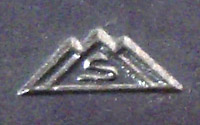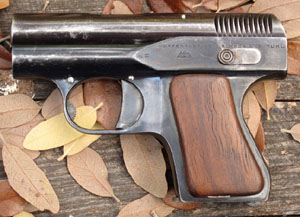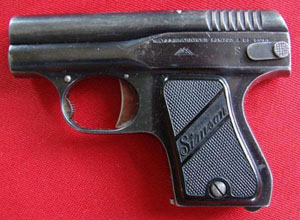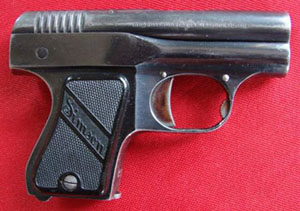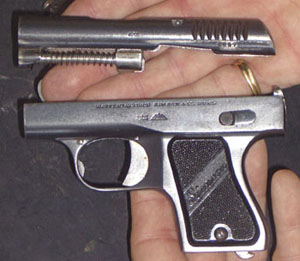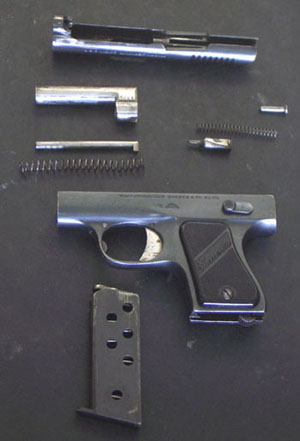 |
||||||||||||||||||||||||||||||||||||||||||||||||||||||||||||||||||||||||||||||||||||||||||||||||||||||||||||||||||||
|
The Simson Model 1922 and 1926 by Ed Buffaloe
Following the treaty of Versailles, the Inter-Allied Disarmament Commission banned the manufacture of military weapons in Germany, except for export, and between 1919 and 1924 supervised the destruction of millions of small arms in Germany. In the early 1920s the German military and police requested permission from the Commission to obtain parts for the repair of P -08 Parabellum (Luger) handguns, and to manufacture new guns. While agreeing to the request for parts as well as for new pistols, the Disarmament Commission insisted that the old arsenal at Erfurt (where military Lugers had previously been made) remain closed, and ordered that Erfurt’s Parabellum manufacturing equipment and spare parts be shipped to the Simson factory in Suhl. In 1925 Simson was given a government contract to manufacture 10,000 P-08 pistols. Subsequent conspiracy theories suggested collusion between Jewish members of the Commission and the Simson family to give the contract to Simson. In fact, the Simson Company was hesitant at first to accept the contract, but ultimately submitted the lowest bid. As a result of its successful fulfillment of the contract, Simson became the leading weapon maker in Central Germany (Thuringia) and the only licensed maker of machine guns and military pistols. Simson’s success aroused the resentment of other gun makers in Thuringia. In March of 1933, after Hitler became Chancellor, the Association of Zella-Mehlis Gun Manufacturers, led by Fritz Walther, sent Hitler a letter complaining that Simson held a monopoly that was forcing them out of business. Because he was a Jew, Arthur Simson (the grandson of the company founder, Moses Simson) and several of his employees were eventually jailed by the Nazis in 1935. After seven months in prison, Simson was forced to admit evading income taxes and to sign the rights to his company over to Nazi Gauleiter Fritz Sauckel. A few months after his release on bail, Simson fled to Switzerland and eventually to the United States of America. Sauckel renamed the company Berlin-Suhler Waffen- und Fahrzeugwerke (BSW), but after the assassination of the Swiss Nazi Party leader Wilhelm Gustloff, Sauckel renamed it Gustloff Werke.* The P-08 Parabellum machinery in the Simson factory was removed to the Heinrich Krieghoff Waffenfabrik, which was also located in Suhl. The Model 1922
The production Model 1922 had a grip plate that appears to be hard rubber (though it may be an early form of plastic) with a single screw at the bottom and the name Simson in script at an angle of about 40 degrees across the grip. Before the serial numbers reached 1000, the slide serrations were reduced to 7 and were made more coarse. The circular grooves on the safety lever were replaced with fine checkering. The timing of these changes is not known precisely. The lockwork of the Simson vest pocket pistol is unusual. The sear and transfer bar are integral, the transfer bar being stirrup-shaped like the Browning, with a lobe on either side at the top which serve as a disconnector. The sear is attached to the rear of the stirrup-shaped transfer bar and moves between the arms of a T-shaped rail at the rear of the frame, referred to in the manual as the slide guide. The trigger pushes the front portion of the connector up, causing the sear to tilt downward, releasing the striker to fire the gun.
The Model 1926 In 1926 Simson updated the gun to make it easier and cheaper to manufacture, and the new version is known as the Model 1926. It is sometimes referred to as the Model 1927. The two guns have similar markings, and are identical in mechanical function. The frame was milled flat on the sides all the way to the front, and on the later production guns the slide serrations were increased to 8 (some early Model 1926 guns still have 7). I note a single example with 15 slide serrations, a presentation pistol dated 1938, after the company was taken over by the Nazis. There is a small cutout milled on each side of the upper slide where the pin for the extractor goes. Both models are scarce in the U.S., but through the power of internet networking, we know that serial number 2226 is a First Variant (Model 1922) and serial number 2271 is a Second Variant (Model 1926). Further data is welcomed. The Second Variant serial numbers run from at least 2271 almost to 5000, then there is a large gap and the numbers start up again in the 20,000 range. I estimate that probably less than twenty-thousand pistols were made, in total. (If you have a Simson, please send me the serial number and I will update my list here.*) The Simson 6.35mm pocket pistol is a simple unlocked breech blowback design with the extractor and ejection port on top of the gun. The take-down latch is on the forward portion of the trigger guard, and the gun is much easier to disassemble than the Browning pocket pistols of similar size. One simply has to remove the magazine, pull the trigger (after ascertaining that the gun is unloaded), press the latch, and draw the slide forward off the receiver. The recoil spring guide rod is removed from the rear of the barrel lug, and then the spring and barrel are easily separated from the slide. The transfer bar is pressed backward with a finger and the safety latch is rotated downward to the vertical and pulled out the left side of the gun until held in place by a spring -loaded plunger. Then the slide guide/sear support block is pushed forward slightly and hooked out of the receiver along with the transfer bar. The transfer bar and slide guide can then be separated. The gun’s only screws are the two that hold the grips on. The quality of manufacture appears to be quite high. There are no machine marks on the interior or exterior of the gun. The slide is almost circular in section and the receiver is shaped to fit it precisely. The forward end of the slide has a downward projection that supports the end of the guide rod, and the barrel lug supports the rear portion of the barrel/slide assembly. The only true rail is at the rear of the gun, as part of the sear support.
|
||||||||||||||||||||||||||||||||||||||||||||||||||||||||||||||||||||||||||||||||||||||||||||||||||||||||||||||||||||
|
||||||||||||||||||||||||||||||||||||||||||||||||||||||||||||||||||||||||||||||||||||||||||||||||||||||||||||||||||||
|
Copyright 2007-2021 by Ed Buffaloe. All rights reserved. |
||||||||||||||||||||||||||||||||||||||||||||||||||||||||||||||||||||||||||||||||||||||||||||||||||||||||||||||||||||
|
|
||||||||||||||||||||||||||||||||||||||||||||||||||||||||||||||||||||||||||||||||||||||||||||||||||||||||||||||||||||
